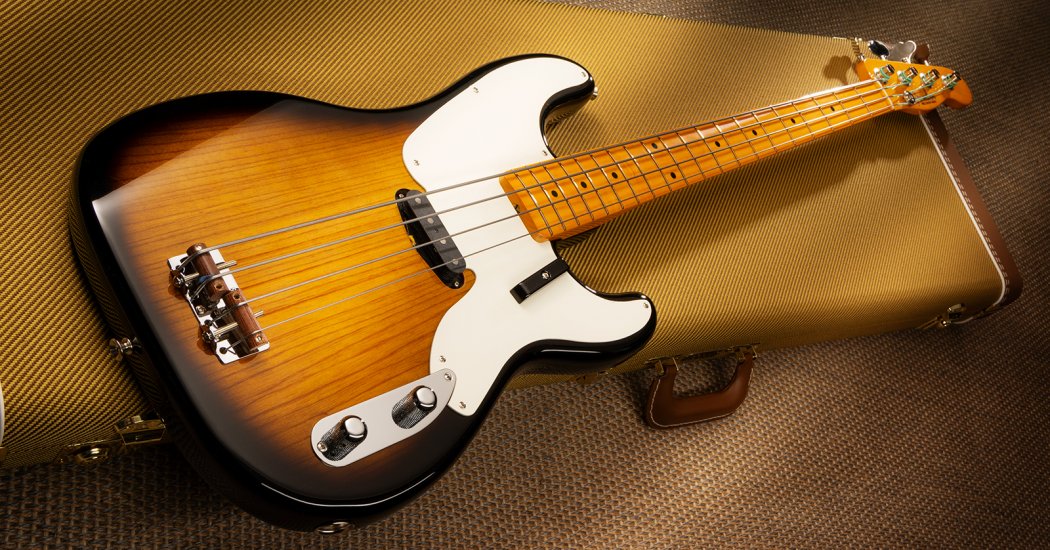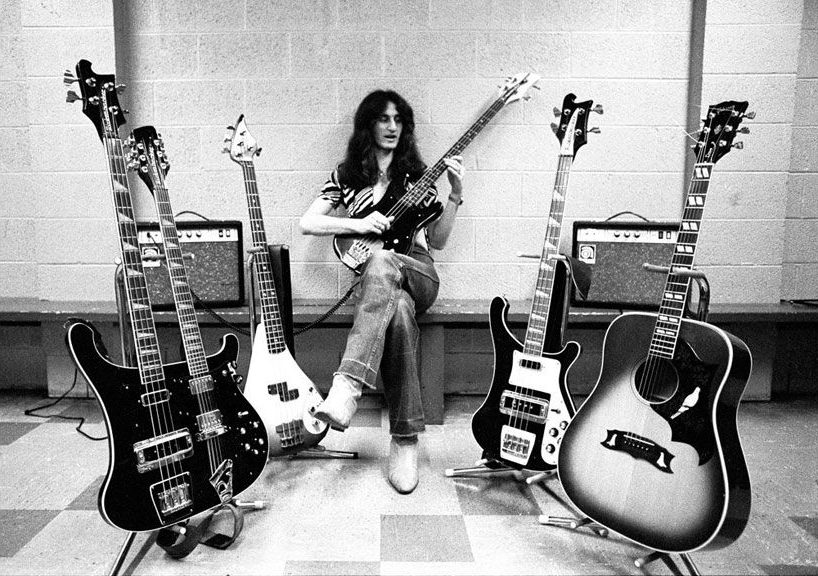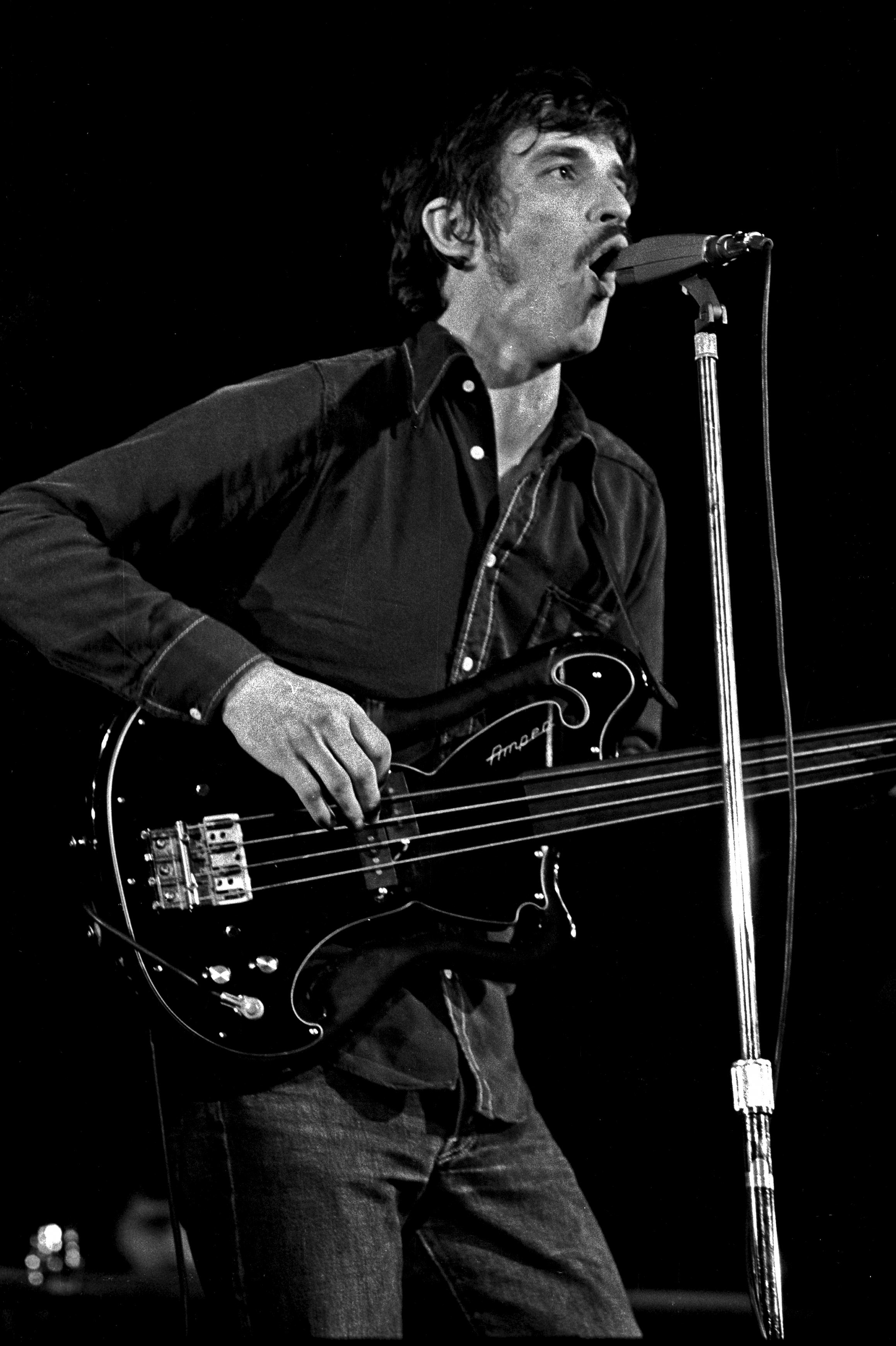
From a cumbersome, fretless acoustic instrument to the high-performing musical tool we know today, the electric bass guitar has a long and storied history brought to life by inventors, businesses, bassists, and believers in musical ingenuity. Closely tied to the invention and evolution of the electric guitar, the electric bass guitar found its corporeal form blooming amidst a crossroads of early electrical innovation. Its roots are cemented in hundreds of years of low-end acoustic history and amalgamated with the modern era’s most technologically advanced inventions. But how did it all start? Let’s go back to the beginning.
- Acoustic Instruments & Music of the Era
- Sparks Before the Flame
- History’s First Solidbody Electric Bass Guitar?
- Early Electrified Upright Bass Models
- The Advent of Rock ‘n’ Roll Demands a Change
- Enter: Leo Fender & the Precision Bass
- End of Story, Right? Wrong!
- 1952: Kay Musical Instruments Devises the Second Bass Guitar
- 1953: Gibson’s Electric Bass
- 1956: Danelectro’s Low-end Foray
- 1956: Hofner’s 500/1 (the Beatle Bass)
- 1957: Rickenbacker Returns with the 4000
- 1958: The UK’s First Solidbody Electric Bass Guitar
- The Fledgling Electric Bass Takes Flight
- Where Are We Now?
Acoustic Instruments & Music of the Era
Before the 20th century and until the 1950s, the role of the bass frequencies was produced by acoustic instruments — most popularly by the upright double bass or the guitarron. These instruments had a warm, acoustic, and projective quality that melded perfectly with the rest of the acoustic ensemble. One of the first iterations of guitar-like features merging with a bass instrument was the Mandobass, which was used in mandolin orchestras from the late 1800s to 1930s [1]. This instrument had frets and could be played sideways, almost like a guitar.
Jumping forward a few decades, Regal Musical Instrument Company devised an instrument in 1937 called the Bassoguitar. It stood around six feet tall, had frets and four strings, and looked like an acoustic guitar. The primary difference was that it was massive and designed to be played like an upright bass. But for popular music of the era — jazz, ragtime, big band, and classical — the upright bass reigned supreme.

Lardyfatboy, CC BY-SA 4.0, via Wikimedia Commons
Everything was destined to change once guitars received the gift of amplification, a technology that emerged for electric guitars first but then made its way over to the bass. The upright, or “doghouse bass,” had kept up sonically for years. Recording artists and bass players preferred the warm, natural sound of an acoustic bass over the poor sound quality of its amplified counterpart. While early amplifiers could pass for the guitar, the technology didn’t have a grasp on low frequencies. As time passed, the increasing volume of horns, acoustic instruments, drum sets, and electric guitars necessitated a breakthrough. But before we get to the mass-market invention that changed the course of music forever, let’s dive into some of the early pioneers of electrified instrumentation.
Sparks Before the Flame
Our electrical story begins at one of the most interesting points in America’s history — at least in terms of technological discovery. Electric bass guitars, as you probably know, derive their amplified sound from an electrical pickup device, just like electric guitars. One of the first recorded uses of electricity for a musical instrument was in 1890 when George Breed registered his electric guitar pickup system with the United States Patent and Trademark Office [2]. You can read more about this and the history of the electric guitar in our article below.
Many more pickup designs soon followed, but it wasn’t until the 1920s that a pickup system was utilized for a bass instrument. In his last year working for Gibson, Lloyd Loar developed the prototype for an upright bass that used a pickup device [3]. Gibson never released the design to market, so it languished unrealized in a warehouse. Loar later left the company and continued experimenting with electrification for his company, Vivi-Tone [4].
Through the decade of the Great Depression, the 1930s saw the development of other similarly electrified bass instruments: the Vega Electric Double Bass, the Rickenbacker Electro Bass Viol, and the Regal Electrified Double Bass, to name a few [5]. All of these designs were conceived for the platform of the upright bass, and the advent of a true solidbody bass guitar waited in the wings.
History’s First Solidbody Electric Bass Guitar?
The 1930s were known as the Golden Age of Radio. During this time, the popularity of technology skyrocketed, changing the way listeners consumed music [6]. Big bands and jazz bands were in their heydays, but their increasingly boisterous sound — mixtures of horns, drum kits, and strings — overwhelmed the acoustic upright basses. At the same time, the surge of newly developed electric guitars threatened them even further. It was clear the industry needed a change. Aside from that, the sheer bulk of upright basses made every gig an ordeal of transportation. Sometimes unable to cram their massive bass into the band’s van, the bassist had to walk or drive to gigs alone [7].
Then came a musician and inventor from Seattle, Washington, who saw the need for an instrument with less bulk and more amplification. In 1935, after many years of successful pickup development and guitar manufacturing, Paul Tutmarc released a cello-sized solidbody bass instrument referred to as an “electric bull-fiddle” [8]. Though a far cry from an electric bass guitar, it was proof that solidbody electric bass instruments were becoming a reality.
But many cite Tutmarc’s Audiovox 736 Bass Fiddle, released to market in 1936, as the first solidbody electric bass guitar ever made. Although previously obscured in the annals of history, Paul Tutmarc is now regarded as the inventor of the solidbody electric bass guitar in a form we recognize today. His Audiovox 736 Bass Fiddle was the first of its kind. Musicians could play this bass horizontally like a guitar, and it had frets for maximum note precision — this made it easy for non-bassists to pick up the instrument, too. Its solid body was carved from black walnut, and it featured a neck-through design and an ebony fingerboard. Its total length measured 42 inches, and it had a scale length of around 30 inches with 16 frets adorning the fingerboard. Of course, Tutmarc designed an amplifier to accompany the instrument: the Audiovox 936 [9]. At the time, the 736 sold for $65, while the amplifier sold for another $75 [10]. Check out the video below to see this bass in action — with electronics in perfect condition. Wow!
Tutmarc devised the perfect instrument for bassists. The weight and reduced bulk would surely appeal to “poor bull fiddlers” [9]. So, why was the instrument lost to history for so long? Although Tutmarc’s and others’ pickup designs of the decade worked well enough, the amplifiers had yet to catch up. They couldn’t output adequate quality sound at high volume levels. Furthermore, the popular music of the time still required the tone of a true acoustic instrument. Nobody was playing incredibly loud, fast music yet. Additionally, during the Great Depression, many Americans did not have the disposable income to invest in untested technologies. It would be 15 years before another inventor made the right product at the right time.
Early Electrified Upright Bass Models
Though Tutmarc was the first to amalgamate the above qualities into a bass instrument, he wasn’t the first to experiment with pickups. In fact, several other music companies of the day were releasing their electric guitars to the market when the 736 Bass Fiddle entered the scene. A company called Rickenbacker developed a horseshoe pickup design and was successfully manufacturing electric instruments. And if you know your electric guitar history, then you’ll remember that the first solidbody electric guitar — the A-22, or the “Frying Pan” — was designed in 1931 by George Beauchamp [11]. Sweetwater was lucky enough to have one of these on our Gear Exchange. You can check out gear expert Mitch Gallagher talking about the history surrounding the instrument below.
With this technology, the company designed an electrified upright instrument called the Rickenbacker Electro Bass Viol. This bass instrument had many characteristics similar to the prototype Loar built in 1924 and, in fact, looks startlingly similar to electric upright basses of today. This Rickenbacker Electro Bass, developed around 1935 to 1936, featured an aluminum frame and was incredibly slim. The end pin of the bass plugged directly into the accompanying amplifier! This model didn’t catch on, but that didn’t stop Rickenbacker from becoming one of today’s most revered and beloved bass guitar makers [3] [5]. (Fun fact: Rickenbacker amps later influenced Leo Fender, who had repaired them in his shop.)

doryfour, CC BY-SA 2.0, via Wikimedia Commons
As mentioned before, Regal and Vega also introduced similar instruments in the 1930s. Their electric upright basses were slim versions of their acoustic counterparts, but these models were built using wood frames instead of aluminum. Again, bassists of the time didn’t have the money or the musical inclination to invest fully in this new technology [12].
The Advent of Rock ‘n’ Roll Demands a Change
During the 1950s, television started to eclipse the medium of radio for top consumer media. The US economy was bouncing back from WWII, and the population felt secure enough to spend its income on nonessential goods. The kids and teens of the era — which were numerous thanks to the Baby Boom — became distinctly different from their parents and grandparents, many of whom had been directly affected by the Great Depression or World Wars. Because of this expanding new culture, music experienced a drastic change.
The skyrocketing popularity of blues, country, gospel, jazz, and R&B led to the birth of a genre that changed music forever: rock ‘n’ roll. Popular radio disc jockey Alan Freed coined said term and hosted a program featuring prominent R&B and early rock ‘n’ roll songs — then referred to as “race music” and scorned by many large radio stations [13]. The genre exploded through Freed’s popularization of African American music for white audiences and the appearance of artists like Elvis Presley, Chuck Berry, Buddy Holly, Bill Haley, and many more early rockers. This laid the groundwork for the most groundbreaking invention in electric bass guitar history.
Enter: Leo Fender & the Precision Bass
By 1951, the stage was set. Fender Musical Instruments Corporation released their Precision Bass to the market. And the rest is history — well, not so fast. This electrified version of a bass instrument wasn’t a new idea, and it certainly wasn’t new to amplify a guitar. Why did the P Bass become the first commercially successful electric bass guitar in history? Well, it has a lot to do with the quality of the product, the time it was released, marketing, and, of course, music.
Building on years of past electrical and musical history, Fender created an instrument completely unique from any previous electric bass instrument. Having found success for his Telecaster/Broadcaster/Esquire guitar lines, Fender took attributes of these instruments — most notably a Telecaster bridge pickup minus two pole pieces — and used them for a lower-frequency, four-stringed version.
The P Bass itself was engineered almost flawlessly — bassists today still buy 1950s reissues to get that same style and tone. Plus, unlike 1937, when Tutmarc was advertising his 736 Bass Fiddle, amplification quality had progressed. This new bass didn’t sound like an acoustic upright, but it also didn’t sound like the electric basses that came before. What’s more, its fretted neck, horizontal positioning, and guitar-like tuning appealed to guitarists as much as bassists. Switching from one fretboard to another fretboard, minus two strings, seemed less daunting.
Fender also had the benefit of better advertising; they put the P Bass into their catalogs and got instruments into the hands of famous and respected players. In fact, by 1957, Presley’s bassist Bill Black had switched to a Precision Bass around the same time they filmed Jailhouse Rock [14].
Fame didn’t come to Fender all at once, though. Instead, the company built up a reputation over the years. But once the Precision Bass took hold, it spread like wildfire. Pioneering bassists like Monk Montgomery, Carol Kaye, and James Jamerson made the instrument a desirable sound and a hitmaker. Suddenly, the electric bass was everywhere. People referred to the Precision Bass simply as the “Fender Bass.” In 1960, Fender continued their electric bass domination when they released the Jazz Bass, an offset body counterpart made to appeal to jazz musicians. For more about the early history of Fender’s basses, check out the articles below!
End of Story, Right? Wrong!
The invention of the Fender P Bass proved that the electric bass guitar was relevant — and other companies noticed. By the end of the ’50s, rock ‘n’ roll and rockabilly were in full swing, growing in popularity through the ’60s and beyond. The electric bass — mainly the P Bass — soon became a stage and studio staple. Thanks to Fender, the electric bass guitar took a steady hold on consumers, and the following companies helped bring low-frequency musical dreams to fruition with their unique models.
1952: Kay Musical Instruments Devises the Second Bass Guitar
By 1952, Kay Musical Instruments had an electric bass guitar of their own: the K-162 Electronic Bass [15]. This became the second bass guitar ever made. Instead of copying Fender’s solidbody success, Kay struck out on their own. The K-162 was essentially the same design as their electric guitar, the K-161 — much like Fender had used the Telecaster as a basis for the P Bass [16].
Unlike the P Bass, the K-162 was a semi-hollowbody, and it is now regarded as one of the first semi-hollowbody electric instruments ever produced. While the P Bass had a cutting, driving sound, the K-162 output a more mellow and acoustic-driven sound. Howlin’ Wolf’s bassist, Andrew “Blueblood” McMahon, played a K-162. As such, the K-162 is frequently referenced as the “Howlin’ Wolf” bass [16].

Bklynbass, CC BY-SA 3.0, via Wikimedia Commons
1953: Gibson’s Electric Bass
Given the previous years of 20th-century instrument electrification, it is no surprise that the first bass from Gibson resembled the acoustic upright. In fact, Les Paul was responsible for the body shape of Gibson’s first electric bass model, the EB/EB-1. Don’t be fooled by the early EB (or Electric Bass) F-holes; this model was a solidbody bass guitar. To make their instruments distinctly different from Fender’s, Gibson gave the EB its violin body shape crafted from mahogany and a shorter, 30-1/2-inch scale. Another factor that gave the EB-1 bass a different feel than the P Bass was its extendable end pin. Indeed, you could play this bass just like an upright! This design influenced a later violin bass with the same look and charm. Gibson later developed the EB-0 and EB-2 basses and renamed the EB to the EB-1 [17].
1956: Danelectro’s Low-end Foray
Before Danelectro considered a 4-string electric bass guitar, the company released the UB-2, a 6-string electric bass/baritone guitar [18]. Realizing they’d have more success in the burgeoning 4-string market, Danelectro soon released the 3412 Short Horn. Unlike many of the basses in this article, the Short Horn had only 15 frets along its neck. Its minuscule size and shorter scale made it an easy instrument for guitarists to switch to.

Enrico Di Pierro from Viterbo, Italia, CC BY 2.0, via Wikimedia Commons
1959 saw the release of Danelectro’s most visually recognizable electric bass guitar: the 4423 Longhorn. (Fun fact: the pickup covers for early Danelectro guitars and basses came from a cosmetic supplier — they were actual lipstick tubes [18]!) Musicians like John Entwistle, Tom Petty, Graham Nash, and Link Wray used the Longhorn during their careers.
1956: Hofner’s 500/1 (the Beatle Bass)
First debuted to the public in 1956, the Hofner 500/1 Violin Bass would make history with one of the biggest bands of all time. Walter Hofner’s expertise in the classical stringed instrument realm made it easy for him to design this alternative to the upright double bass, answering Gibson’s EB-1. Its hollowbody nature made it incredibly light and provided a rich, warm sound — especially when paired with flatwound strings [19]. In the early 1960s, the Beatles bassist Paul McCartney popularized this instrument, and the market for Hofner 500/1 basses exploded. McCartney would use 1961 and 1963 models for most of his Beatles career and beyond. Had the P Bass met its mass-produced match?

VARA, CC BY-SA 3.0 NL, via Wikimedia Commons
1957: Rickenbacker Returns with the 4000
It was six years after the invention of the Precision Bass before Rickenbacker entered the solidbody electric bass guitar game. Despite the company’s popularity today, Rickenbacker started with a minuscule splash in the electric pool. But as 1957 rolled around, the Rickenbacker 4000 was born from the minds of Roger Rossmeisl, Paul Barth, and F.C. Hall. No other bass on the market looked like it. The 4000 utilized unique Rickenbacker designs, flaunting avant-garde curves and a horseshoe pickup not dissimilar to the ones used on Rickenbacker’s previous electric upright basses.

Tim, CC BY 2.0, via Wikimedia Commons
Much like the P Bass, the 4000 model electric bass did not attain immediate commercial success. That didn’t deter Rickenbacker. Instead, they forged onward with their 4001 model. Strikingly similar, the 4001 nevertheless displayed more outward flash, given its deluxe features [20]. Thanks to players like Paul McCartney, Roger Waters, Geddy Lee, Lemmy Kilmister, Chris Squire, and Kim Gordon, as well as movements like the British Invasion, the Rickenbacker 4001 went down in history as one of the world’s favorite electric bass guitars. Models sold today are almost entirely unchanged from that first 4001 design. Hey, if it ain’t broke, don’t fix it.
1958: The UK’s First Solidbody Electric Bass Guitar
America had the P Bass in 1951, but it took years for the UK to have a solidbody model of their own. Due to the UK’s postwar import embargo, nobody could get an American-made electric bass in the UK. Supersound Electronic Products solved that issue in 1958 with their Supersound Electric Bass Guitar. This solidbody electric bass guitar had comfort curves accentuated by a startlingly sharp cutaway. Unlike the P Bass, the Supersound Bass had a shorter, 30-1/2-inch scale length with 20 frets. This bass was equipped with a Supersound Hi-Fi single-coil pickup that doled out low-end tones with classic ’50s warmth. Soon afterward, Supersound’s double-cutaway bass followed, flaunting dual sharp edges that gave it a stunning quality [21]. You can listen to some history and check out some versions of the Supersound guitars and basses below!
The Fledgling Electric Bass Takes Flight
Once rock ‘n’ roll and popular music skyrocketed the electric bass guitar into popular culture, other electric bass guitar designs hit the scene. Manufacturers now had the time, resources, knowledge, and expertise to develop unique, out-of-the-box models, each with an unmistakable tone and playability — not to mention looks.
For instance, in 1967, Hagstrom Guitars developed a novel electric bass guitar: the Hagstrom H8. The H8 was the first mass-produced 8-string bass. Hagstrom positioned the strings on the H8 similarly to a 12-string guitar, doubling them up in four runs and tuning the strings an octave apart. Hard-rock icons loved the sound, and its double-cutaway body commanded attention on any stage [22]. Artists such as Jimi Hendrix, Noel Redding, and Lemmy used the H8 during their careers.

Musik- och teatermuseet, CC BY-SA 3.0, via Wikimedia Commons
As the instrument gained popularity, famous players like Bill Wyman and Jaco Pastorius decided they’d rather play fretless. It wasn’t until 1966 that the commercial world acknowledged the merit of producing fretless basses. Seeing a gap in the market, Ampeg developed a fully fretless instrument inspired by upright basses and bass guitars. The company landed on the design for the AUB-1, a fretless version of its AEB-1 model. Consequently, both were the first horizontal models made by Ampeg; after all, the company was more invested in the amplifier game [23].
The AUB-1 and AEB-1 took the headstock, neck, and fingerboard of an upright bass and merged them Frankenstein-style with an electric bass guitar’s body. Now, the amplifier company had a foot in the electric bass game, and their introduction was to release the world’s first commercially available fretless bass! The fretless fingerboard allowed for unencumbered playing and new techniques to bloom, further developing the instrument into something playable in a myriad of exciting new ways.

Heinrich Klaffs, CC BY-SA 2.0, via Wikimedia Commons
As the 1960s rolled along, companies like Yamaha, Teisco, and Guyatone dipped their toes in the electric bass guitar waters. Other companies like Ibanez, Ernie Ball Music Man, ESP, G&L, B.C. Rich, Cort, Alembic, Warwick, and more blossomed in the growing electric bass guitar market, each offering a unique sound and playability from their instruments. The doors were open for basses of all kinds.
Where Are We Now?
It’s been an exciting journey investigating the electric bass guitar’s history. The idea could never have come to fruition if not for the countless hours spent improving technology, experimenting with pickup designs, building prototypes, and listening to the wishes of gigging bassists. That being said, I’m blown away by the sheer sonic power and streamlined playability of today’s bass models! There are 5-, 6-, 7-, and 8-string models and more. There are fretted and fretless basses — even a fretted/fretless 7-string Ibanez Bass Workshop SRAS7 Ashula bass guitar. There are solidbody basses, hollowbody basses, and everything in between. There are acoustic bass guitars, electric bass guitars, and acoustic-electric bass guitars.
The past innovations have culminated in a current musical instrument manufacturing era that can give you virtually any electric bass guitar you could ask for — how cool is that? From early pickup designs by Breed to ear-pummeling, high-performing basses heard on today’s stages, the history of the electric bass guitar is one of the most fascinating in music history.
We’re Music History Lovers at Sweetwater
While we don’t sell Paul Tutmarc’s 736 Bass Fiddle, we do sell almost any other bass guitar you could ask for — even Fender Custom Shop bass guitars made to look like they emerged straight out of the ’50s. Curious? Call your Sweetwater Sales Engineer at (800) 222-4700, and get cookin’ with a new low-end friend. Want something genuinely of the era? Then check out the basses on Sweetwater’s Gear Exchange — you may be surprised at what you can find.
Not enough low-end trivia for you? Head over to the articles below to learn more about famous bass guitar brands and some of the most talented musicians to play the instrument.
Sources
[1] Gruhn, George. 2013. Gibson Style J Mando-bass.
[2] Breed, George. 1890. Method of and Apparatus for Producing Musical Sounds by Electricity. United States of America Patent 435,679. January 31.
[3] Vintage Guitar. 2007. Rickenbacker Electro Bass. Accessed June 20, 2023.
[4] Mandolin Cafe. n.d. Mandolin Glossary: Lloyd Loar. Accessed June 16, 2023.
[5] Marx, Wallace, Jr. 2010. Electric Bass Origins, Part 1. Accessed June 16, 2023.
[6] University of Minnesota. 2016. “6.2 The Evolution of Popular Music.” In Understanding Media and Culture, 258–352. Minnesota: University of Minnesota Libraries Publishing.
[7] Port, Ian S. 2019. The Birth of Loud. New York: Scribner.
[8] Blecha, Peter. 2005. Tutmarc, Paul (1896-1972), and his Audiovox Electric Guitars. Accessed June 16, 2023.
[9] Blecha, Peter. 2017. The Audiovox 736 Electric Bass and 936 Amp. Accessed June 16, 2023.
[10] Blecha, Peter. 1999. Audiovox Electronic Bass: Discovered! The World’s First Electric Bass Guitar. Accessed June 20, 2023.
[11] Rickenbacker International Corporation. n.d. The Earliest Days of the Electric Guitar. Accessed June 16, 2023.
[12] Harvey, Gareth. 2022. Electric Upright Bass Guitars: History and a Brief Guide. Accessed June 16, 2023.
[13] Nayman, Louis. 2012. Rock ‘n’ Roll Payola: Dick Clark and Alan Freed. Accessed June 16, 2023.
[14] Bacon, Tony. 2020. Did Leo Fender Really Invent the Electric Bass? Accessed June 16, 2023.
[15] Cook, Steve. 2010. Kay K162 Pro Bass Review. Accessed June 19, 2023.
[16] ChasingGuitars. n.d. Kay History. Accessed June 20, 2023.
[17] Fly Guitars. n.d. Gibson EB / EB-1 Bass. Accessed June 21, 2023.
[18] Moseley, Willie G. 1999. Danelectro Guitars: The Return of Danelectro. Accessed June 21, 2023.
[19] Hofner. n.d. The Violin Bass. Accessed June 21, 2023.
[20] Kohman, Peter Stuart. 2012. The Bass That Waited: Rickenbacker’s Early 4000 and 4001. Accessed June 21, 2023.
[21] Free, Jon, Paul Day, et al. n.d. SUPERSOUND 1958. Accessed June 21, 2023.
[22] Hagstrom. n.d. Hagstrom H8II Bass. Accessed June 21, 2023.
[23] Bass Player Staff. 2020. A quick history of the fretless bass. Accessed June 22, 2023.


